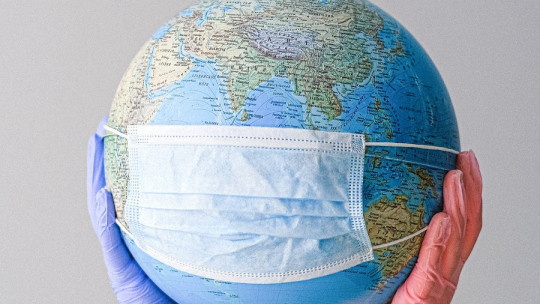
The health, economic and social crisis caused by the coronavirus has irreparably affected, although not in the same way, the world population. And it has left a fairly dense residue when it comes to mental health.
Currently, it is estimated that diagnoses of mood disorders have increased by 25% in the child and adolescent population.
Next We will see what have been the most influential factors that the pandemic has had on mental health of the population of Spain, possible effects and healthy and respectful forms of management.
Pandemic factors most influential on mental health
The World Health Organization (WHO) defines a pandemic as the worldwide spread of a disease and emphasizes the fact that there is no prior immunity to the new pathogen. In the case of the coronavirus, the first contagion was reported on December 31, 2019 in Wuhan, and the first measures were taken to contain it in Spain on March 9, 2020 with the suspension of face-to-face educational activities in the Community of Madrid. . Both the lack of knowledge of the transmission mechanisms, the lack of previous exposure and the lack of resources to confront it led to measures as radical and unusual as the previous one.
There are a multitude of factors that may have influenced the management that each person has been able to make of the situation, each of us is different. However, The studies carried out to date indicate that those that have most affected the Spanish population have been the following.
1. Use of alarmist messages
There are words that, through learning, we have associated with danger. That is why, by keeping them in mind, our brain activates response mechanisms to the threat that increase the level of stress so that we can cope with it (increase in heart rate, redistribution of blood to the extremities, decrease in skin moisture… etc.).
This means that all our energies will be distributed in such a way that all those abilities that favor survival in a physical and primitive way can be activated and maximized, while other functions will be relegated to the background. Although these threat response mechanisms have little place in today’s world, they are still valid in our body (surely you are able to identify more than one moment in which they have come into play throughout your life) .
Is about a situation of sustained stress over time that can lead to mental and physical health problems which should preferably be supervised by a professional.

2. Loss of daily routine
Daily routines give us structure and certainty. They allow us to know what is going to happen in our lives, organize ourselves and anticipate what may happen. The need for confinement prevented the normal life of the vast majority of the Spanish population given that, until now, teleworking represented an underrepresented percentage within the work dynamics. Regulated education, for its part, did not have the necessary means to continue its activity normally.
This new situation implied that minors had to remain at home, with the consequent supervision of adults. Some of them essential workers, others self-employed, teleworkers or people who simply had to resign or suddenly lost their jobs.
3. Information management
The adaptation of the content to minors, the feeling of lack of precise information, the erratic measures and the well-known infodemic (information pandemic), a phenomenon consisting of an excess of information, not always contrasted or appropriate to the population that receives ithave been quite a challenge during the crisis.
4. Use of the mask
Although the responses to the imposition of its use have been very diverse throughout the world, from the feeling of security and responsibility, to the feeling of oppression. In Spain, most of the people surveyed reported feeling social distance, in addition to difficulties in communication..
Likewise, it has represented an added difficulty for those who require lip reading to complete the communicative information and an obstacle for the acquisition of language in the little ones.
5. Confinement and isolation
Although it is true that these are the most effective methods for containing infectious diseases and have also been the most used historically, they are unusual measures due to the low threat they pose today. The difference between both, confinement and isolation, lies in whether or not the diagnosis is confirmed in the identified person or persons.. While confinement is the measure prior to confirmation, isolation is the one applied once the disease has been diagnosed.
The restrictions on being able to leave the home have led to a greater amount of time shared with the rest of the cohabitants or greater isolation for people who live alone. In both cases, the difficulties have not been few: people who lived with partners or family members have been forced to share more time, and this time has not always been of quality due to regulation difficulties.
Intimate violence has intensified (both within the family and within the couple), mental health relapses have been triggered, or new disorders have come to light as a result of this stressful situation. Added to this have also been the consequences of the lack of health care for chronically ill patients, who have seen their mental health diminish.
6. Perception of an uncertain future
This is a rare event, which we have not previously experienced in this adult generation and those close to us, so we do not have direct experience about recovery or the consequences.
7. Social isolation
It has been promoted by containment measures and maintained by the lack of resources to stay connected. This isolation has meant large differences depending on age or socioeconomic level: it has slowed down the socialization processes of the little ones; It has distanced the elderly due to a lack of technological knowledge and has opened a socioeconomic gap in which those with less purchasing power have seen their ability to continue with education or social relationships conditioned.
- You may be interested: “Unwanted loneliness: what it is and how we can combat it”
Common conditions
As mentioned in several points of the article (it is important not to lose sight of this), individual circumstances, as well as emotional resources and supports, make the experience different for each person. However, scientific evidence reveals the following symptoms as the most common among the Spanish population.
1. Headaches and tension pain
The most referred by neurologists in the general population; They have to do with the physical expression of emotional tension.
2. Insomnia
Intimately linked to the lack of routine. In adolescents, it has also been intensified by an intrinsic characteristic of this stage of development: delayed sleep.
Adolescents, as in all life stages, have their own sleep cycle. In their case, they enjoy greater ease in staying awake at night and drowsiness in the morning.
The lack of school routine has favored the natural tendency of adolescents to stay up late, so waking up has also been delayed and thus altered rhythms. Lack of sleep, for its part, usually causes irascibility and promotes emotional instability.
- Related article: “Insomnia: how it impacts our health”
3. Bruxism
It can be day or night. Consists in clenching or grinding teethand is usually related to periods of stress.
4. Emotional lability
It consists of having an irregular, unstable mood. The pressures of an unusual life or sharing space with other cohabitants for a longer period of time, as well as the feeling of loneliness can promote emotional changes and difficulty regulating.
5. Physical exhaustion
Derived from sleep disturbances, emotional exhaustion or the inability to carry out usual exercise routines.
6. Mood disorders
It means reaching one more step in discomfort. Symptoms of anguish or deep sadness appear that last more than fifteen dayssleep or appetite disturbances, memory problems, slowing or agitation of thinking.
Keys to understand yourself, understand yourself and move forward respectfully
Whatever symptoms may have appeared, they are evidence that something is not working as well as it should. Consulting with a professional can provide the necessary tools to initiate changes that lead to well-being.
On the other hand, individual experiences are completely different from each other. Nevertheless, Below are some tips to provide good support in the return to normality..
1. Validate your experience and that of others
If you are facing another person, try to put yourself in their position. It is very likely that their difficulties are different from yours, but just as valid, painful and important..
If you are the one who is suffering from a difficulty, give it the importance it deserves, trying to minimize it will not make it go away.
2. Ask for help from trusted people and specialists
Humans are social beings and, as such, we need other people to live and develop. Psychologists, educators, teachers, family and friends can be great allies.
3. Update yourself with reliable sources
At this time, there is fairly precise information about the spread of the virus and the effectiveness of protective measures. Having accurate information provides a feeling of security and control of the situation. Remember to adjust the content when you are the one transmitting it.
Some of the ones you can consult are: World Health Organization (WHO), the Ministry of Health, United Children’s Fund (UNICEF) or the Spanish Journal of Public Health (RESP).
4. Approach your goals safely and respectfully
Set your final goal and intermediate steps to get there, this way it will be easier to see the results. small daily achievements. Remember to choose realistic objectives and respect the process times.
5. Look for spaces, companies and motivating activities
Motivation is the impulse that leads us to action. The more pleasant stimuli we have around us in difficult situations, the easier it will be for us to face them.
6. Make measures more flexible within safe limits
Flexibility in any situation is one of the most valuable and useful resources that we can exercise.. It allows us to give each event the importance it deserves and deploy the necessary means to function in a comfortable and tight manner, without overexerting ourselves or burdening ourselves.
Keeping yourself informed to be able to make appropriate decisions can free up important mental space and emotional burden about this circumstance and leave you free to enjoy much more pleasant situations.
7. Normalizes the need for (self)care in any situation and individual differences
The novelty and intensity with which we have experienced the pandemic has meant that (self) care has been focused on protecting ourselves from the virus. Care is much more.








